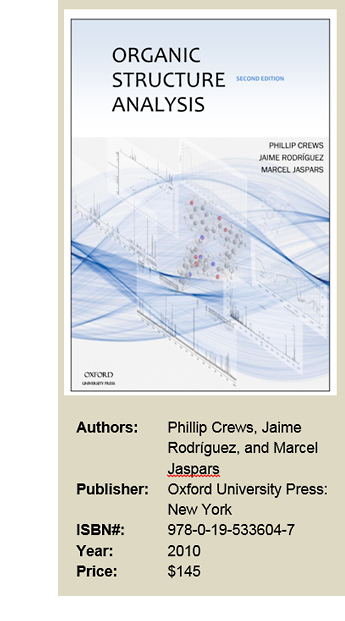 Many undergraduate chemistry programs are offering upper-level coursework in organic structure determination. This type of class is useful to upper-division students. The additional skills gained are applicable for other advanced courses, independent research projects, and future graduate studies. Many undergraduate chemistry programs are offering upper-level coursework in organic structure determination. This type of class is useful to upper-division students. The additional skills gained are applicable for other advanced courses, independent research projects, and future graduate studies.
The Crews text is very useful for a 400-level special topics class, particularly if the pedagogical style of the professor leans towards inquiry-driven or "flipped classroom" models of teaching. Many aspects of the text make it highly suitable for an introductory graduate or upper-level undergraduate course.
The book has a number of very useful tables, but this is not a reference book. Rather, it is instructional in nature. There are questions at the end of each chapter and a solutions manual provided to instructors. The solutions manual is valuable. Because the solutions are not to be found in textbook itself, the end-of-chapter questions are suitable for use as graded assignments. The chapters are laid out logically, beginning with a general introduction into the use of spectral data and a chapter on the basics of nuclear magnetic resonance, with subsequent chapters covering the most practical details of single and multidimensional NMR techniques. Other spectroscopic techniques covered in the book include mass spectrometry and infrared and ultraviolet spectroscopy. There are three chapters dedicated to mass spectrometry, with the general layout being similar to that for NMR (basic concepts, followed by detailed modern techniques and relevant applications of those techniques). The last two chapters are dedicated to the use of combined techniques in order to determine complex organic structures and are the capstone experience of a course of this type.
The text itself is readable, although still challenging for students whose last experience with spectroscopic structure interpretation was sophomore organic chemistry. What I particularly like about this book is that unlike sophomore-level, and even some upper-level, textbooks on this topic, the answers to questions are not simply to be found buried in the text. Enough information is generally given, but the students must engage themselves fully in the "More Challenging Problems" in order to arrive at the solutions. There are also references for outside reading in many of the end-of-chapter problems. This feature can be a double-edged sword to smaller institutions that may lack access to a 1978 article from Tetrahedron Letters, for example. With advanced planning, however, an instructor could either take advantage of inter-library lending or skip a particular question.
When looking for resources for an organic structure determination course, one tends to find texts that are either somewhat oversimplified or overly detailed in the treatment of NMR principles. The Crews text offers a middle ground, where basic principles are covered at a high, but reasonable level and concepts are reinforced by challenging problems. This blend of explanatory text, extremely useful data tables and conceptual questions makes the Crews text a highly suitable choice for the upper-level undergraduate or beginning graduate student.
|
